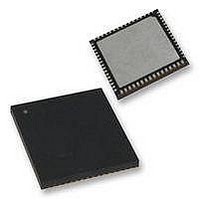PIC24FJ64GA106-I/MR Microchip Technology, PIC24FJ64GA106-I/MR Datasheet - Page 185

PIC24FJ64GA106-I/MR
Manufacturer Part Number
PIC24FJ64GA106-I/MR
Description
16-bit, 16 MIPS, 64KB Flash, 16Kb RAM, 84 I/O, NanoWatt 64 QFN 9x9x0.9mm TUBE
Manufacturer
Microchip Technology
Series
PIC® 24Fr
Datasheet
1.PIC24FJ128GA106-IPT.pdf
(330 pages)
Specifications of PIC24FJ64GA106-I/MR
Core Processor
PIC
Core Size
16-Bit
Speed
32MHz
Connectivity
I²C, IrDA, LIN, SPI, UART/USART
Peripherals
Brown-out Detect/Reset, LVD, POR, PWM, WDT
Number Of I /o
53
Program Memory Size
64KB (22K x 24)
Program Memory Type
FLASH
Ram Size
16K x 8
Voltage - Supply (vcc/vdd)
2 V ~ 3.6 V
Data Converters
A/D 16x10b
Oscillator Type
Internal
Operating Temperature
-40°C ~ 85°C
Package / Case
64-VFQFN Exposed Pad
Processor Series
PIC24FJ256GA110
Core
PIC
Data Bus Width
16 bit
Data Ram Size
16 KB
Interface Type
UART, I2C, SPI
Maximum Clock Frequency
8 MHz
Number Of Timers
5
Operating Supply Voltage
3.6 V
Maximum Operating Temperature
- 40 C to + 85 C
Mounting Style
SMD/SMT
Lead Free Status / RoHS Status
Lead free / RoHS Compliant
Eeprom Size
-
Lead Free Status / Rohs Status
Details
- Current page: 185 of 330
- Download datasheet (3Mb)
16.0
The Inter-Integrated Circuit (I
face useful for communicating with other peripheral or
microcontroller devices. These peripheral devices may
be serial EEPROMs, display drivers, A/D Converters,
etc.
The I
• Independent master and slave logic
• 7-bit and 10-bit device addresses
• General call address, as defined in the I
• Clock stretching to provide delays for the
• Both 100 kHz and 400 kHz bus specifications.
• Configurable address masking
• Multi-Master modes to prevent loss of messages
• Bus Repeater mode, allowing the acceptance of
• Automatic SCL
A block diagram of the module is shown in
16.1
The I
cannot be reassigned to alternate pins using Peripheral
Pin Select. To allow some flexibility with peripheral
multiplexing, the I2C2 module in 100-pin devices can
be reassigned to the alternate pins designated as
ASCL2 and ASDA2 during device configuration.
Pin assignment is controlled by the I2C2SEL Configu-
ration bit; programming this bit (= 0) multiplexes the
module to the ASCL2 and ASDA2 pins.
2010 Microchip Technology Inc.
Note:
processor to respond to a slave data request
in arbitration
all messages as a slave regardless of the address
2
2
C module supports these features:
C modules are tied to fixed pin assignments and
INTER-INTEGRATED CIRCUIT
(I
Peripheral Remapping Options
2
Section 24. “Inter-Integrated Circuit
This data sheet summarizes the features of
this group of PIC24F devices. It is not
intended to be a comprehensive reference
source. For more information, refer to the
“PIC24F
(I
C™)
2
C™)” (DS39702).
Family
2
C) module is a serial inter-
Reference
2
C protocol
Figure
Manual”,
PIC24FJ256GA110 FAMILY
16-1.
16.2
The details of sending a message in Master mode
depends on the communications protocol for the device
being communicated with. Typically, the sequence of
events is as follows:
1.
2.
3.
4.
5.
6.
7.
8.
9.
10. Wait for and verify an Acknowledge from the
11. Enable master reception to receive serial
12. Generate an ACK or NACK condition at the end
13. Generate a Stop condition on SDAx and SCLx.
Assert a Start condition on SDAx and SCLx.
Send the I
with a write indication.
Wait for and verify an Acknowledge from the
slave.
Send the first data byte (sometimes known as
the command) to the slave.
Wait for and verify an Acknowledge from the
slave.
Send the serial memory address low byte to the
slave.
Repeat Steps 4 and 5 until all data bytes are
sent.
Assert a Repeated Start condition on SDAx and
SCLx.
Send the device address byte to the slave with
a read indication.
slave.
memory data.
of a received byte of data.
Communicating as a Master in a
Single Master Environment
2
C device address byte to the slave
DS39905E-page 185
Related parts for PIC24FJ64GA106-I/MR
Image
Part Number
Description
Manufacturer
Datasheet
Request
R

Part Number:
Description:
Manufacturer:
Microchip Technology Inc.
Datasheet:

Part Number:
Description:
Manufacturer:
Microchip Technology Inc.
Datasheet:

Part Number:
Description:
Manufacturer:
Microchip Technology Inc.
Datasheet:

Part Number:
Description:
Manufacturer:
Microchip Technology Inc.
Datasheet:

Part Number:
Description:
Manufacturer:
Microchip Technology Inc.
Datasheet:

Part Number:
Description:
Manufacturer:
Microchip Technology Inc.
Datasheet:

Part Number:
Description:
Manufacturer:
Microchip Technology Inc.
Datasheet:

Part Number:
Description:
Manufacturer:
Microchip Technology Inc.
Datasheet:










